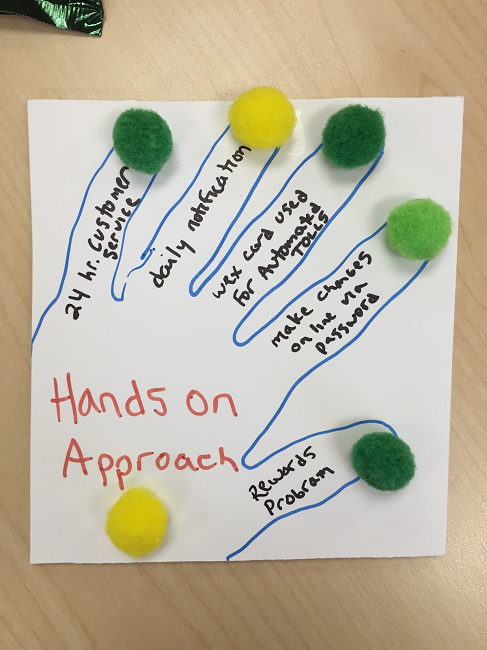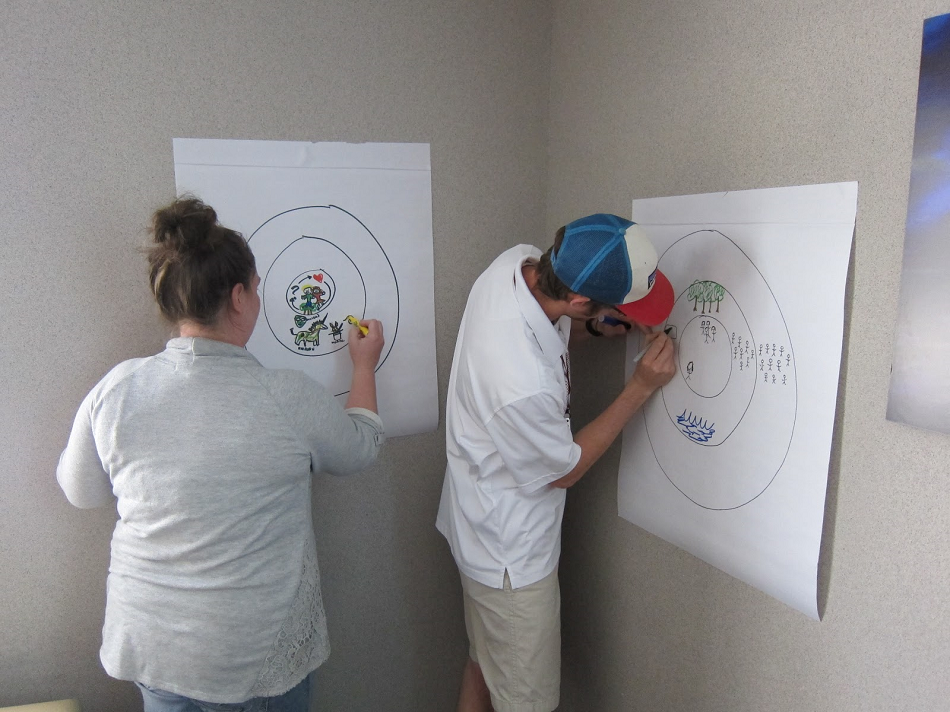As organizations embrace design-led innovation, they can struggle to reap the full value of human-centered design. A design team’s interactions with customers may often be limited to only the early research and late evaluation phases of the design process, while the work in between – when ideas are being generated – is left to the internal team alone. When this is the case, we miss the opportunity to discover some of the most valuable and customer-centered solutions.
Cue participatory design.
Participatory design is an approach to design strategy that brings customers into the heart of the design process. Also known as “co-creation”, “co-design”, or “cooperative design”, it emcompasses techniques useful to both initial discovery and subsequent ideation phases of a project, where the end-users of a product, service, or experience take an active role in co-designing solutions for themselves.
Understanding how someone would solve a challenge they face directly often surfaces new insights about their experiences. This new information better informs how designers focus their efforts, and the ideas users propose serve as actionable inspiration for the solutions created. Whether designing for consumers, employees, service providers, or other audiences, when we move past the challenge of designing for them and begin designing with them, we find the outcomes are more innovative and customer-centered.
What is Participatory Design?
What it is:
An approach to design that invites all stakeholders (e.g. customers, employees, partners, citizens, consumers) into the design process as a means of better understanding, meeting, and sometimes preempting their needs.
What it is not:
- A way to “make your users do your job for you”
- A single prescriptive method or tool
- A rigidly defined process
- A holy grail
Let’s take a look at a few ways participatory design can be valuable in practice.
Participatory Design in Practice
Finding deeper nuance for a large health insurance network
An health insurance insurance provider sought to design a new member portal that provides a highly personalized and anticipatory digital experience for all members. The design process was supported by participatory design sessions that helped drive designers toward a more anticipatory experience.
Role of Participatory Design:
- Love Letter/Breakup Letter Activity: Rather than asking people what they like or don’t like about a service or brand, this method provides insight into customers’ perceptions by eliciting feelings of appreciation, frustration, or aversion through writing a hypothetical love letter or breakup letter directed at the service or organization. We can draw on the content and tone of the letter, as well as body language when members read it aloud, to build empathy and discover which experiences will be most likely to create, maintain, or harm brand loyalty as we design potential solutions.
- Empathy Collage: Visual associations allow people to reframe their perspective and make potentially abstract connections between their experiences with a product or service. This activity helps customers’ express their experiences and needs in a way words can sometimes fail to describe. Participants are always placed at the center of the collage, which allows us to understand how they conceive of their own role in their interactions with the organization.
- Magic Screen Activity: People can often identify hidden opportunities and potential design value through a co-creation process. Providing participants with materials that allow them to engage in a hands-on “making” activity provides us with a sense for what features or functionality may be most important (or least important), and often reveals insights about customers’ mental model for interactions.
Result:
This work resulted in a personalized, anticipatory experience that included certain tools and content identified by customers as higher priority than the organization’s stakeholders and designers expected. In our workshop, these customers described what they wanted in familiar terms. However, seeing how they actually built and sketched imaginary solutions showed us that many assumptions about their priorities were incorrect, once we saw what they created in participatory design sessions. Giving customers an opportunity to design a solution, rather than just asking them to talk about it, provided that important nuance. We might have designed an experience that was highly streamlined and intuitive without their help, but the benefit of having customers co-design the experience was that we ended up focusing on more than just an intuitive experience, focusing instead on one provides personalized, proactive suggestions instead of building a more general home for commonly useful content.
[see Case Study 1 photos]


Building empathy and understanding within a large fleet management company
A number of different approaches were applied for a fleet management company to uncover unmet needs and provide an actionable design roadmap for fleet management app features moving forward.
Role of Participatory Design:
- Journey Mapping: Customers can map out their current experiences, including pain points, frustrations, challenges, and areas for opportunity, in a way we sometimes can’t even with plenty of ethnographic research. We find that we get richer information by extracting it within the context of an entire experience, rather than asking about the issues as a standalone exercise.
- Lensed Brainstorming: Customers can often generate a lot of great ideas in a short time. To inspire ideas, we use lenses: words representing concepts or ideas that help us look at a problem or scenario in a different way.
- Magic Button: Think of the Staples Easy Button or a magic wand. The Magic Button activity invites customers to imagine the best experience imaginable. In order to capture these insights, we ask questions like, “What would a magic button do?”
Result:
We identified key challenges and insights that had gone uncovered by prior research, and integrated those findings into a strategic roadmap for the client’s mobile app, online platform, and marketing solutions. Seeing customer’s reactions and ideas firsthand built empathy among stakeholders and helped guide the product roadmap with the customer’s voice in mind.
[see Case Study 2 photos]



Tackling a stubborn challenge through co-design with Muskegon Family Care
Three of our designers partnered with Muskegon Family Care, a federally qualified health center, to tackle the high rates of patient no-shows and low patient engagement. We hypothesized that if we could understand what patients found valuable in their clinical visits, identify the barriers that kept patients from the visits, and improve the experience of the patient-clinician interaction, then both clinicians and patients would find the appointments more valuable. This, in its turn, would reduce the no-show rate.
Role of Participatory Design:
- Circles of Me: Rather than simply asking people what is important to them, this method facilitates participants through visually capturing their needs and desires in a hierarchical manner. Fashioned as a bullseye, in the innermost circle participants include things and relationships they value the most. In the subsequent circles, participants put other people/things/relationships important to them in descending order. This method is able to identify what participants really value, helping us better understand their needs and desires in order to design with them.
- Role-playing: Based on the work of the researcher and educator Vivian Paley, this exercise helps build empathy by creating a shared understanding of both the patient’s and clinician’s experience. While participants acted out their stories to illustrate their solutions, this also helped shape the ideal care center experience.
- Rapid Prototyping: Rapid prototyping is a quick way to get a sense of how a solution might work in the real world by using simple supplies such as paper, Playdough, pipe cleaners, Legos, and other basic supplies. By rapidly prototyping solutions, participants and designers have a chance to critique the ideas and quickly make changes without spending a lot of time and energy making something perfect before evaluating it.
- Round Robin: This activity allows ideas to evolve as they are passed from person to person. This strengthens ideas and creates holistic solutions by incorporating multiple viewpoints. After participants created their prototypes in groups, they moved through a series of rotations where they were prompted to add their own knowledge and suggestions to each of the prototypes
Result:
Participatory design opened the door to rich conversations around the unmet needs hindering face-to-face clinical appointments. Through our collaborative workshop with clinicians, patients, and staff members we learned how critical personal connection is for this audience and the roles shame and financial hardship play in scheduling appointments. This level of understanding would not have been possible without bringing diverse stakeholders together in an environment that facilitated their creative thinking. By the end of the two-day collaboration, the group of patients, clinicians, care center staff, and designers created two solutions to the patient no-show challenge as well as a strategic implementation plan. This plan guides the clinic through several steps: low-risk pilots, incorporating later iterations based on results of the evaluation, facilitating final implementation within the clinic, and finally, measuring success.
[see Case Study 3 photos]


Helping Behavioral Health Innovators empower the disenfranchised
Behavioral Health Innovators (BHI) sought to create a series of co-design workshops by partnering with high school students in recovery from addiction.
Mad*Pow worked closely with these students to understand and document the underlying causes of their substance abuse, map their journeys through addiction and recovery, and facilitate the creation of several prototypes of interventions that could help other young adults.
Role of Participatory Design:
- Super Powers: This is an ice-breaking collaborative activity where participants are invited to share their imagined super powers as a way to introduce themselves. Instead of simply stating they are a student or a parent, they created their introduction using the Super Power cards. This allows the group to understand their strengths, especially when considering how to work with other group members, and how to apply any insights made outside of the workshop.
- Opportunities Identification: In this activity, participants are prompted to use journey maps to think about opportunities, or the situations where they feel like things might have gone differently. Participants can think of the different opportunities at every stage of their journey, such as situations where they could have benefited from talking to a friend, or an adult who knows them well, who could have offered help, but didn’t.
Result:
We used collaborative activities to facilitate co-design with the students. These activities revealed an unexpected depth of the problem that simple quantitative data or structured interviews simply wouldn’t have revealed. We discovered concern over lack of social support, and no belief that they could positively affect their futures. In behavior intervention design, this determinant is called self-efficacy. In the vernacular, we call it hope.
Through our collaboration with students, our lived experience experts, we were able to learn about the paths to addiction that result from deeper and more complex issues, and the solutions that the students felt most connected to. Prototypes created in this co-design workshop addressed social needs and finding new ways to connect youth at risk for addiction, or those recovering from addiction, with other sober teens or adults.
[see Case Study 4 photos]


In sum:
Involving the people we’re serving through design as participants in the process helps ensure that our solution addresses their life holistically. It makes sure we don’t reduce people to discrete behaviors separated from the context of their lives, communities, aspirations, or value structures. This type of approach allows us to address root causes of the problems rather than symptoms, and, therefore, leads to better experiences & outcomes.
People can often identify hidden opportunities and potential design value through a co-creation process. Viewing participants as subject matter experts — involving them in the process of co-creation — we can start to see their needs differently and understand how our solutions fit into the bigger context of their lives.








